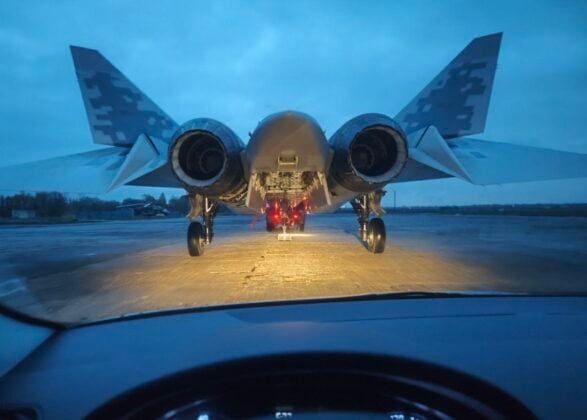
A previously unseen image of Russia’s Su-57 multirole fighter has surfaced on pro-Kremlin social media channels, showing the aircraft’s internal tail-mounted weapons bay in detail.
The release appears to be part of a broader effort by Moscow to promote the export potential of the fifth-generation jet as it seeks foreign funding to complete development.
The Su-57, known to NATO as “Felon,” is equipped with multiple internal weapons bays to preserve its low radar signature. According to publicly available data, the aircraft features 8 to 10 internal hardpoints spread across several compartments—two types of which are clearly defined: a central fuselage bay, designed to carry long-range cruise missiles like the Kh-69 and conventional bomb loads, and side-mounted wing root bays typically used for air-to-air missiles. Depending on the mission profile, the configuration of these bays can be altered, allowing for flexibility across combat roles.
In addition to internal mounts, the Su-57 also includes external hardpoints beneath its wings, enabling it to carry additional guided bombs, cruise missiles, or air-to-air weapons. However, the use of external pylons compromises the aircraft’s radar cross-section—something the internal bays are specifically intended to minimize.
The origin of the photo remains unknown. No date or location was published alongside the image, and no official statement has been released by the Russian Ministry of Defense or the aircraft’s manufacturer, Sukhoi. The appearance of the image on Kremlin-aligned Telegram channels suggests the disclosure was deliberate.
The Su-57 program, though technically in serial production and officially accepted into service, remains incomplete. As noted by Russian defense observers, the aircraft still lacks a modern engine, fully integrated avionics suite, and combat-proven weapons package. In its current form, the platform relies on legacy components and interim systems pending completion of the full development cycle.
Russia has been actively promoting the Su-57 abroad, especially in China and India, using diplomatic channels and defense exhibitions to generate interest. As noted in Russian-language posts circulating this week, Moscow urgently needs foreign investment to continue the program, which has faced delays and budget constraints since its early stages.
The aircraft has previously been displayed at airshows and in state media with its weapons bays closed. This is one of the first visual disclosures to focus on the rear internal bay, providing insight into its geometry and structural design. While the image has not been independently verified, the level of detail shown is consistent with what is known about the airframe’s layout.
Internal weapons bays are a defining feature of fifth-generation fighters, including the American F-22 Raptor and F-35 Lightning II, designed to preserve stealth performance by avoiding external stores. The Su-57’s modular bay system, if functional as intended, would provide it with comparable versatility across missions while maintaining a lower radar signature during initial strikes or air superiority roles.
However, the lack of a next-generation engine—intended to be the Izdeliye 30—along with limited evidence of operational deployment, continues to raise doubts among analysts about the Su-57’s combat readiness. Russia has claimed combat use of the aircraft in Ukraine and Syria, but only as a cruise missile launcher.
The timing and content of the image’s release point to a renewed public relations campaign by Moscow to shape perceptions of the Su-57’s maturity. Whether aimed at domestic audiences or potential export customers, the message is clear: Russia wants its stealth fighter seen not just as a prototype or a testbed, but as a weapon system ready for global sales.